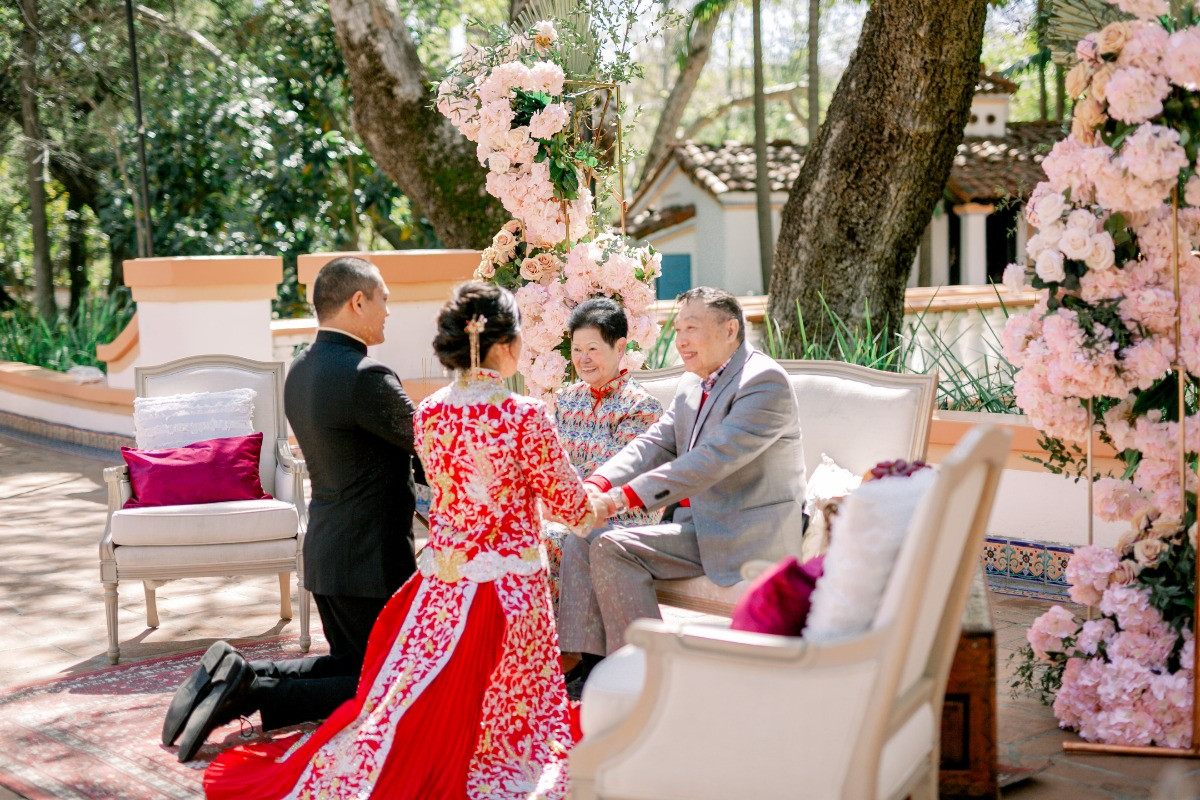How To Plan A Chinese Wedding Tea Ceremony

As an important tradition in Chinese weddings and culture, the wedding tea ceremony is an opportunity for the newlyweds to show respect for their elders, and a chance for their family to share their acceptance of the marriage in return. It is usually conducted on the day of the wedding itself and is a significant and meaningfully part of the day. It sees the bride and groom serve tea to their parents, in-laws and often other family members and symbolises the union of two families. The ceremony typically takes place within the family homes and the couple are usually dressed in traditional wedding garments, with on hand assistance typically from the bridesmaids. In most cases the parents and the in-laws are the main recipients, but sometimes grandparents, aunts and uncles are included too. It is usually an intimate, close family only affair.
History
Before we go into the details of ‘how’ to plan a Chinese wedding ceremony, it’s important to understand the ‘why’ and the reasons for the ceremony coming to be.
The tradition goes as far back as the Tang Dynasty in China (618 - 907), with tea seen to represent faithfulness. According to ‘Seven Revisions’ by Chinese writer Ying Lang (1487 - 1566) “the tea plant cannot be transplanted, and after transplantation, it shall not live. When a woman marries and brings tea as part of her dowry, we see she is loyal to one”.
In modern times it still symbolises this, but is also crucially seen as a signifier of both families welcoming the bride and groom into the fold. It also provides an opportunity for the couple to express their gratitude and form a promise that they will continue to respect their elders henceforth.
1. How to plan a wedding tea ceremony
Speak to your families about who you plan to invite
Usually the only attendees to the wedding tea ceremony are the couple, their parents and other important family members including grandparents and aunts and uncles. In addition to this, the bridal party is often in attendance to help with making the tea and washing up.
2. Choose your location
Traditionally the wedding tea ceremonies take place in the family home, with one home visited after another. Typically the tea ceremony for the bride’s family happens in the morning, with the groom and groomsmen coming to collect her to hold the other tea ceremony at his family home. It’s recommended to do both visits all in one, go but the location can be flexible if required, for example if you’re hosting a lunch within a wedding venue.
3. Timing of the ceremony
The tea ceremony typically takes place on the day of the wedding, and as mentioned before, in the earlier part of the day. There is no particular length of time that the tea ceremony needs to be, however it’s important to not rush proceedings.
4. General etiquette
When serving the tea, the bride and groom should first face the relative of their gender. The father of the groom is then served by the groom and the bride thereafter. The mother of the groom is served by the groom, and shortly after the bride. This order is also used for grandparents and other relatives too. During the process of physically serving the tea, you should address the family member you are serving in kinship terms, pass the the teacup with both hands and when serving say “please drink the tea”. Traditionally both bride and groom kneel whilst doing so, with the option of touching their head to the ground to show ultimate respect.
When it comes to kneeling, some couples might only choose to kneel to serve their parents and in-laws and some may choose to not do it altogether. This is usually something that is spoken to family about prior to the ceremony, however if your parents or in-laws request that you do kneel, then it can be a tricky one to say no to.
5. Types of tea to use
There are no real rules on what tea should be served, and is entirely down to personal preference. However additions are often added to the tea for symbolism, including red dates (for luck), lotus seeds (for arrival of children) and lily. In China, the name for lily rhymes with a phrase that means marriage longevity, hence the reason for its addition to the teacup.
6. Chinaware and cushions
The Chinaware and kneeling cushions are usually purchased by the bride’s family and are Chinese in style, typically featuring the ‘double happiness’ Chinese character that symbolises weddings on them. As suggested, the cushions are for family members to comfortably kneel on.
7. After the tea ceremony
Once the tea ceremony has been completed, parents usually give their wise words to the couple and gift them with a Lai See - a red envelope containing money, a symbol of luck and good fortune. The groom’s parents will usually gift the bride gold jewellery, for example the ‘dragon and phoenix badges’ that are a traditional wedding accessory. It’s traditional that the bride must put these on straight away, in order to not offend or give off the impression she doesn’t like them.
